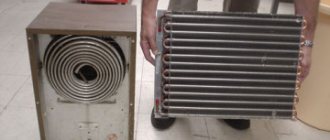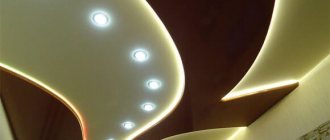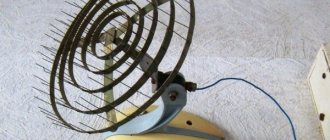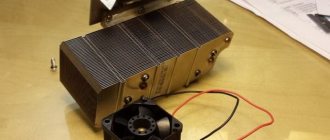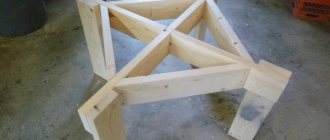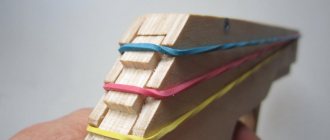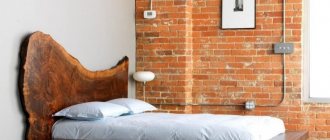Do-it-yourself air humidity meter: instructions for assembling a hygrometer To control the microclimate of the room, you will definitely need special devices. This also applies to a device with which you can monitor the amount of water vapor that may be present in the air.
Agree, not only excessive dryness, but also excess humidity negatively affects the health of people living or working here. So why not try making your own air humidity meter that will help for different situations?
Next, we will talk about the principle of operation of the hygrometer, and also provide instructions for self-assembly of several simple devices.
Hygrometer models
| Device name | Price | Advantages | Flaws |
| MAX-MIN | 600 rubles | Equipped with a thermometer and a clock with alarm. An additional sensor can be connected. | There are no disadvantages. |
| Digital moisture meter with remote sensor. | 250 rubles | Humidity measures from 10 to 99%. The kit includes an LR44 battery. Using the device you can work remotely. | The measurement error is too high - 7-8%. Moreover, the device quickly breaks down. |
| Stanley 0-77-030 | 6000 rubles | It has a shock-resistant case, an LCD display, and is small in size. | High price. |
| HP-2GD | 600-700 rubles | User-friendly interface, easy to use. Just click on the button and select the desired option. | Low quality case material. |
| Ryobi Phoneworks RPW-3000 | 2200 rubles | It is compatible with the operation of a smartphone; data can be received directly on the phone screen. | There are no disadvantages. |
| DC-206 | 300 rubles | The model has compact dimensions and can be used in small incubators. | The body is easily deformed under mechanical stress. |
| HTC-2 | 600 rubles | Has a built-in thermometer and clock. | No. |
| TA308 | 700 rubles | 3 in one: humidity sensor, clock and thermometer. | High error of indicators: above 5%. |
If you are wondering which is the best of all the options, then this title is occupied by the MAX-MIN device (3 in one).
This is not just a humidity sensor. The plastic case contains a thermometer for the incubator, which shows the temperature values as accurately as possible. The device is also equipped with a clock and alarm. In addition, an additional MAX-MIN TH218A humidity sensor can be connected to it. By placing it directly inside the housing, you don’t have to worry about disturbing the internal microclimate in the incubator.
The sensor readings are as accurate as possible with an error of 1%. If the humidity level changes, an audible alarm will sound, allowing the poultry farmer to quickly become aware of any violations.
The thermometer lets you know if the temperature sensor is working properly. After all, if deviations from the norm are too large and quite frequent, then there is a high probability of problems in its functioning. It needs to either be replaced or configured correctly.
An alarm clock is also an important and indispensable tool. Especially if you have to work with a manual incubator, when you need to turn the eggs yourself. By setting it to fire every 4-5 hours, you will never forget that you need to perform masonry manipulations.
The screen of the equipment is large, divided into three segments (for humidity, temperature and clock). All indicators are visible from afar, highlighted in bright colors. Therefore, you don’t have to approach the incubator every time, because data on its operation can be viewed from a distance. I am especially pleased with the cost of the device - only 600 rubles.
How to make an electronic humidity meter
The hygrometer is of great importance in agriculture, especially during crop storage. The electronic meter is the most modern. But, you can make it yourself. Here's the diagram. All information about it can be seen here: https://aes2.ru/publ/indikator_vlazhnosti_vozdukha/1-1-0-122
Electronic meter circuit
This device is suitable for rooms where food is stored.
Consists of the following parts:
- Control board. Its size is 6.5 cm by 9.8 cm.
- Sensor. Size 2cm by 5.3cm;
- Button SW1;
- Resistor 470 kOhm. It will indicate an increase in humidity.
Power is supplied by a 9 volt battery.
The advantage of the circuit is the ability to connect several detectors.
Its work is based on the connection of two 2N2222 transistors. You can use transistors in plastic cases or other bipolar transistors.
The essence of the robot: a sound piezo emitter is triggered by a current passing between the contacts of the sensor. This occurs after a sufficient amount of moisture has settled on the sensor contacts.
To turn on the signal, 6 mA of current is enough.
The switching threshold is adjusted by selecting the value of resistance R 2 and capacitance C 1.
Copper tinning on the sensor PCB - needs to be done correctly. This will protect against oxidation and loss of electrical conductivity.
Such an indicator, if configured correctly, can be used in a home where a person suffering from asthma lives.
Let's look at another way to make a hygrometer yourself
Hygrometers come in the following types:
- hairline;
- weight;
- ceramic;
- condensation;
- electronic;
- psychrometric (psychrometer).
Let us consider in more detail the technology of operation of each type of device.
Hair hygrometer
Hair hygrometers work on the basis of ordinary hair and its properties. Hair can change its length at different air humidity. It is pulled onto a board or frame and, lengthening or shortening, moves the arrow, which in turn moves along the scale of the device.
Read also: Features of cassette housing of bees in the Berendey pavilions
A hair hygrometer is good for home use if it is not necessary to obtain extremely accurate data.
Also, they should not be moved or otherwise mechanically influenced. At the slightest impact, the hygrometer can fail, since its entire structure is quite fragile and delicate.
Weight hygrometer
An absolute weighing hygrometer consists of several tubes connected to a system. They contain a hygroscopic substance that can absorb moisture from the air.
A certain portion of air, taken at one point in space, is drawn through the entire system.
Thus, a person determines the mass of the tube system before and after passing air through it, as well as the direct volume of air passed through, and with simple mathematical manipulations can calculate the indicator being studied in absolute value.
Mechanical (ceramic) hygrometer
A porous or solid ceramic mass, which also includes metal elements, has electrical resistance. Its level directly depends on humidity.
For it to function correctly, the ceramic mass must consist of some metal oxides. Kaolin, silicon and clay are used as a base.
Condensation hygrometer
This hygrometer is quite easy to use. The principle of its operation is based on the use of a built-in mirror. The temperature of this mirror changes along with the air temperature in the surrounding space.
Its temperature is determined at the initial moment of measurement. Then drops of moisture or small ice crystals appear on the surface of the mirror. The temperature is measured again.
Using the temperature difference determined by a condensation hygrometer, air humidity is determined.
Electronic hygrometer
A layer of lithium chloride is applied to a plate of glass or other similar electrical insulating substance.
Humidity changes - the concentration and resistance of lithium chloride increases or decreases.
It is worth noting that the readings of an electronic (electrolytic) hygrometer may be slightly affected by air temperature, so it is often equipped with a built-in thermometer.
This hygrometer is extremely accurate and gives readings with minimal error.
Psychrometric hygrometer (psychrometer)
The psychrometer is a system of two conventional alcohol thermometers. One of them is dry, and the second is wet (this state is regularly maintained).
The faster moisture evaporates, the lower the relative humidity. The condensed liquid begins to cool. Thus, the difference between the temperatures of two thermometers and the rate of evaporation are determined, and on their basis the air humidity is found.
A psychrometer is not a hygrometer in the literal sense, but it measures the same indicator, so they are often identified.
In fact, the principle of operation of any hygrometer is quite simple and is based on the physical or chemical properties of materials and substances.
Almost any hygrometer is suitable for home use, but the most accurate data is still provided by electronic hygrometers.
"Natural" meter
To make a meter at home, you can use the ability of a cone to straighten or, on the contrary, to compress its scales, depending on changes in environmental humidity. All you need to create the device is the cone itself and a piece of plywood.
A lump is attached to the very center of the plywood using a nail or tape. To determine humidity, you should monitor the rate of opening of the scales. If they open quickly, the air humidity is slightly below normal. If the position of the scales does not change for a long time, the microclimate of the room corresponds to average values. If their tips begin to rise upward, the humidity in the room is high.
Psychrometer - device, principle of operation
Air humidity in an apartment is one of the main indicators of the home microclimate. Too much or too little moisture in the air can cause discomfort and negatively affect your well-being.
Humidity is a measure of the amount of water vapor in the air. The humidity of home air changes depending on weather conditions and human life processes.
Without special equipment, it is difficult to determine the relative exact level of air humidity. However, moisture concentrations that do not meet the norm can be determined by dry skin and mucous membranes or the accumulation of condensation (dew point) on windows and mirror surfaces.
Relative humidity is the content of water vapor in the air and its interaction with air temperature.
A device for measuring air humidity is called a hygrometer.
There are several types of hygrometer:
- hair,
- film,
- weight,
- condensation,
- psychrometric,
- electronic.
Psychrometric hygrometer
The psychrometer is based on the interaction between “dry” and “wet” thermometers. The device contains two thermometers with tinted liquids (red and blue). One of these tubes is wrapped in cotton cloth, the end of which is immersed in a reservoir of solution. The fabric becomes wet, and then the moisture begins to evaporate, thereby cooling the “wet” bulb. The lower the air humidity in the room, the lower the thermometer readings will be.
To calculate the percentage of air humidity on a psychrometer, you should find the air temperature value in the table on the device according to the thermometer readings and find the difference in values at the intersection of the indicators.
There are several types of psychrometers:
- stationary. Includes two thermometers (dry and wet). It works according to the principle described above. The percentage of air humidity is calculated according to the table.
- aspiration. It differs from a stationary one only in the presence of a special fan, which serves to blow the thermometers with an incoming air flow, thereby speeding up the process of measuring air humidity.
- remote. This psychrometer comes in two types: manometric and electrical. Instead of mercury or alcohol thermometers, it has silicon sensors. However, as in the first two cases, one of the sensors remains dry, the second remains wet.
The operation of the psychrometer is based on the degree of cooling by evaporation of the wet-bulb thermometer reservoir with a balance of heat exchange and a constant speed depending on the amount of moisture in the ventilated air flow.
Relative humidity is determined from the wet bulb temperature and air temperature.
The psychrometer consists of two main parts - head 1 and thermal holder 3 (Fig. 1).
Inside the head there is an aspiration device consisting of a winding mechanism, key 2 and a fan for the MB-4-2M psychrometer; The M-34-M psychrometer uses an electric motor with a fan connected to a 220 V AC network.
Thermometers 4 are installed on the thermal holder 3, one of which is “wetted”, and the other is used to measure air temperature.
Thermometers are protected from solar radiation both on the side by 5 strips and on the bottom by 6 tubes.
At the bottom of the heat holder there is a device for regulating the aspiration speed. It consists of a cone-shaped valve 8 and a spring-loaded screw 7. When the screw is turned, a certain part of the cross-section of the tube 9 is closed, which leads to a change in the aspiration rate.
Speed adjustment to a given value is carried out at the factory and, if necessary, at the verification office.
| Rice. 1. Scheme of the MV-4-2M aspiration psychrometer | When the fan rotates, air is sucked into the device, which flows around the thermometer reservoirs, passes through tube 9 to the fan and is thrown out through the slots in the aspiration head. The psychrometer is supplied with: a pipette for wetting, consisting of a glass tube inserted into a rubber balloon with a clamp; shield (wind protection) to protect the aspirator from the influence of wind; a metal hook for hanging the device by the ball on the aspiration head, calibration certificates for thermometers and a passport. To calculate humidity from thermometer readings, psychrometric tables are used or calculated using a formula. Formulas and auxiliary tables for calculating absolute and relative humidity are presented in Appendix 1 |
Types and principles of their operation (and advantages, where it is better to install)
Before installing the sensor, you need to consider factors that affect performance characteristics:
- required accuracy of readings;
- permissible range of humidity values.
Depending on the specified parameters, the optimal device is selected that will help make life in the house more comfortable and cozy.
Capacitive
The operation of the device is based on the principle of changing the capacitance of the air capacitor. The capacitive device structurally looks like a hygroscopic polymer film, around which two electrodes are located. As water molecules increase, the film absorbs them and swells. The distance between the electrodes increases and, accordingly, the capacitance value of the capacitor changes. The capacitive hygrometer is compact, works quickly and has low hysteresis values. Good measurement accuracy due to weak dependence on external operating conditions.
Thermistor
The device consists of nonlinear electronic components, the resistance of which depends on temperature. The design of the psychometric sensor consists of two such elements, each of which is placed under different conditions:
- One is isolated from external conditions and is filled with dry air.
- The other has holes through which air enters for comparative measurements.
The connection diagram of the two components allows you to see the voltage exerted on the dry sample (air) from the first thermistor. Its value indicates that humidity is increased. A zero voltage reading means that the dryness in both thermistors is the same.
Resistive
The operating principle of the device is based on changing the resistance value of the moisture-absorbing material. Hygrometers of this type are inexpensive and are actively used in everyday life.
Design of resistive type detectors
A resistive sensor consists of two electrodes located on a substrate. Aluminum oxide is used as the applied surface layer. It perfectly absorbs moisture, has low resistance, the value of which varies depending on the humidity of the environment.
Optic
This type of hygrometer works on the principle of a capacitor. With the sensor, you can calculate the dew point, that is, the temperature indicator at which drops of condensation begin to be released from the air.
- An LED beam is directed onto the surface of the mirror being tested.
- On the back side, the mirror is heated or cooled depending on external conditions.
- The beam is redirected to the photodetector and the current in the circuit is reduced.
- This turning point is recorded by a temperature sensor.
Electronic
A layer of hygroscopic material or electrolyte - lithium chloride - is applied to a glass or polystyrene plate. The substance is sensitive to changes in humidity and its concentration is decisive for displaying the final readings on the screen. The electronic hygrometer contains a thermometer, which increases the accuracy of measurements. This type of device is used to measure soil moisture (useful for gardening).
Hair device analogue
Anyone who asks the question “how to make a hygrometer with your own hands” very rarely starts creating a hair device. However, it is quite simple to do. For this you will need:
- hair;
- petrol;
- glue;
- nails;
- drawing supplies;
- high density paper;
- plywood sheet;
- pen rod;
- steel wire;
- video clip.
Human hair can be replaced with high quality cotton thread, which also reacts sharply to changes in air humidity.
The hair or thread must be at least 40 centimeters long. If we are talking about hair, it needs to be degreased (wetting in gasoline is used). At the end of the hair it is necessary to attach a weight that is heavy enough to straighten it. A small part of the pen refill, previously rinsed of ink, can be used as such a plumb line. To secure the load you need to use glue. A plastic tube about five millimeters long is placed on a small nail. You can also use the refill of a fountain pen as it. It is important that the tube rotates freely around the nail without jumping off it. To assemble the hygrometer, prepare a horizontal base on which the vertical part of the device will be fixed - a board or plywood. A pre-prepared nail is driven into its center. It must be placed so that the hair thrown through the plastic tube (one third of the entire length) can be attached to the horizontal part with its free end. Fastening is also done using glue. The final stage of the work is attaching a scale, which can be created from a strip of paper by marking divisions on it.
To calibrate the device, bring it into the bathroom in which a hot shower was turned on. Mark the point at which the plumb line will be sharp as 100%. To find the zero mark, you need to put the device in a heated oven (not very hot, so as not to burn the device). After this, exactly between the two points you need to put a mark of 50 degrees. You can calculate decimal or even unit marks in a similar way.
The mark at which the plumb line will be located at the end of the hair will be an indication of the relative humidity of the environment.
Popular types of devices
The procedure and features of measuring humidity levels with a hygrometer depend on the type of laboratory equipment used. Such devices differ in design, operating principle and a number of other parameters.
By design, hygrometers are either mechanical or electronic. The former have a dial with an arrow, the latter have a display on which information is displayed.
Based on the principle of operation, there are the following types of devices:
- film;
- hair;
- weight;
- capacitive;
- resistive;
- ceramic;
- condensation;
- electrolytic;
- psychometric.
Film hygroscopes have a dial with a pointer. The sensor is a special film. It consists of organic material and is connected to the arrow.
Under the influence of changes in atmospheric humidity, the film changes its size. This causes the hand to move to the right or left, showing the result on the dial.
The advantage of a hair hygrometer is its simple design. This device can be used to determine air humidity at temperatures below zero degrees
The main element of hair devices is fat-free human or synthetic hair stretched over a frame with an arrow. The operating principle of the device is similar to film types of hygrometers.
When humidity changes, hair length changes. This leads to the deviation of the arrow in a certain direction.
Weighing hygroscopes are used to calculate absolute humidity. They are equipped with tubes with hygroscopic material. As the air mass passes through, the filler absorbs moisture and increases in weight.
The sample is taken using a special pump. The system is weighed before and after air injection. Absolute humidity is calculated based on the obtained indicators and the volume of air mass passed through.
Capacitive hygrometers incorporate an oxide capacitor. Its capacity varies depending on the moisture concentration in the air. Such models must be periodically calibrated. This is due to the fact that over time the detector capacity decreases, which affects the accuracy of the measurement.
Resistive hygroscopes work on the principle of changing the level of humidity depending on the electrical resistance of salts and polymers. Ceramic instruments consist of a dial with a pointer. The sensor is a special ceramic mixture (clay, silicon). Its electrolytic resistance depends on the level of humidity.
Ceramic hygrometers only show humidity levels. They have no additional functions. But they are accurate and allow you to monitor changes in the indoor microclimate
Condensation type devices are also called Lambrecht hygrometers. The operating principle of the equipment is based on the use of a built-in mirror. The temperature of this element changes along with the temperature of the atmospheric air.
The main element of electrolytic devices is a glass, polystyrene or other insulating plate coated with a layer of electrolyte. Depending on the moisture concentration in the air, the resistance of the electrolyte changes.
The condensation hygrometer is highly accurate. But it is not suitable for household use due to certain difficulties in use.
Psychometric hygrometers measure the humidity of atmospheric air based on the decrease in temperature of a wetted body. They consist of two thermometers: dry and wet.
The device is also equipped with a feeder - a glass flask that is filled with water. The calculation is carried out by the researcher independently. The table included with the device helps you determine the relative air humidity with a hygrometer.
In addition to instruments, there are alternative ways to measure humidity. Read on for more details.
Is it possible to do without devices?
“Folk” methods for assessing air humidity
If we talk about the complete absence of instruments, then, yes, there are a couple of methods, albeit for a very rough estimate of the relative humidity of the air.
An ordinary candle is used for these purposes. To conduct the “experiment,” it is necessary to completely eliminate drafts in the room, that is, close all windows and doors. It is advisable to achieve as much darkness as possible.
A candle flame can indicate excess air humidity.
After the candle is lit, watch its flame.
— An even vertical flame with a yellow-orange tongue and clear boundaries indicates a normal level of humidity.
— If the flame “plays” and the areola around the tongue takes on a crimson color, we can assume excess air humidity.
And that is all…
The second method is using a glass of chilled water.
For the experiment, you need to take a glass of regular tap water and place it in the refrigerator for several hours. It is required that the water cools to about 5-6 degrees.
Glass of water experience
After this, the glass is taken out and placed on the table in the room where the humidity study is being carried out. You should immediately visually evaluate the condensation that appears on its walls after being transferred from the refrigerator.
It is important that the glass is no closer than 1 meter from windows, walls and heating appliances. In this position, avoiding a draft, it is left for about 10 minutes.
After this, an assessment can be carried out.
— If the condensation on the outer walls has dried, this indicates insufficient air humidity.
— The condensation, in principle, has not undergone any significant changes - the humidity can be considered within normal limits.
— Condensation collected in drops and even flowed onto the surface of the table - the air humidity in the room was clearly increased.
Again, there is no need to talk about accuracy. And preparing for the experience, which requires several hours, is also not attractive.
But in general, without instruments, it won’t work out differently.
Homemade psychrometer from a regular home thermometer
Well, if you have at your disposal the most ordinary glass alcohol or mercury thermometer, then humidity can be determined with an accuracy no less than that provided by professional instruments.
Using a regular thermometer it is possible to obtain a very accurate relative humidity reading.
First, you need to place the thermometer in the room where the humidity is determined, so that direct sunlight does not fall on it. It’s best to use it on a table in a shaded place closer to the center of the room. Naturally, drafts must be excluded. After 5–10 minutes, temperature readings in the room are taken and recorded.
After this, wrap the thermometer flask with a richly moistened cloth (room temperature!) and place it in the same place. After 10 minutes, readings are taken, as for a “wet” thermometer in a psychrometer. They write them down too.
Having two thermometer readings on hand, for “dry” and “wet”, you can find a psychrometric table, go into it and determine the level of relative humidity. Better yet, do a more thorough calculation.
Don’t be alarmed, the author is not going to overwhelm you with formulas. All of them are already included in the online calculator offered to your attention.
The calculation algorithm is compiled for normal air movement in a house or apartment, characteristic of the normal operation of natural ventilation.
The calculator asks for one more value - the level of atmospheric pressure in millimeters of mercury. If it is possible to indicate it (you have a barometer at home or have information from a local weather station) - great, the results will be as accurate as possible. If not, well, then leave the normal pressure, the default is 755 mm Hg. Art., and the calculation will be carried out from him.
This calculator should not raise any more questions.
We make a psychrometer with our own hands
For many, store-bought options are either inconvenient or cost too much. Therefore, some owners prefer to make the devices themselves. Is it possible? If you have special materials and basic knowledge, it is possible to make a psychrometer yourself and at home.
First you need to decide what you need for this.
Materials and instructions for creation
Manufacturing the device will require:
- standard alcohol thermometer – 2 pcs.;
- wooden slats of different sizes - 2 pcs.;
- self-tapping screws – 4 pcs.;
- cambric (fabric) – a piece of 2x2 cm is enough;
- water container;
- distilled water or antifreeze (in the volume of the container);
- PVA glue;
- screwdriver;
- pliers;
- hacksaw for wood.
This is what the future design looks like
To begin with, take the largest rail. From it you need to cut a piece measuring 5x12 cm. In the future, it will become a stand for the device. The thickness does not matter, but it is not recommended to take plywood less than 5 mm.
To complete the central part of the device, you will need another rail, which will later become a stand. Its height should correspond to the length of the thermometers themselves. Therefore, the unnecessary part of the plywood is cut off with a hacksaw.
A traverse is installed on the finished rack
It is important that it is mounted at a right angle. Using screws, the thermometers themselves are attached directly to the traverse. The alcohol-containing ends should be directed towards the stand
The alcohol-containing ends should be directed towards the stand.
One of them is wrapped with a pre-cut piece of cambric fabric. The fabric should be applied to the thermometer with maximum density. About 1 cm of cambric is left hanging, since in the future it will serve as a connection between the thermometer and the container with liquid.
The finished tripod with thermometers attached to it is mounted to the stand. The easiest way to do this is to cut a hole in the middle of the plywood stand, equal in area to the stand itself. To keep the structure in place, it is fastened with PVA glue. Place a container of water under the thermometer with cambric.
Do-it-yourself psychrometer for incubator is ready!
How to use
You need to use it according to the following instructions:
the container is filled with liquid (antifreeze); the finished structure is placed in an incubator. It is best to place a homemade psychrometer close to the walls, since in the middle the liquid under the influence of light will quickly evaporate and distort the data
It is also important to take into account that the apparatus must be visible when the incubator is closed; After 15-20 minutes you can already take the first readings. The results obtained are substituted into the table for determining relative humidity in an incubator using a psychrometer:
The results obtained are substituted into the table for determining relative humidity in an incubator using a psychrometer:
Table of values for psychrometer
How to measure indicators in an incubator using a psychrometer?
Each type of device will have its own special instructions. How to use a psychrometer? If we talk about stationary devices, they operate in this way:
- the material that envelops the mercury ball of one of the thermometers is moistened with liquid. It is desirable that it be distilled water;
- turn on the fan;
- the psychrometer is placed against one of the walls of the incubator;
- After 4 minutes, the device is removed and the readings are looked at.
Air humidity is determined using a special table (it is located at the end of this article).
It is also possible to determine the results while the device is constantly inside the incubator. The main thing is to position it so that the scale is visible without opening the box.
The aspiration psychrometer is installed on a special mount so that it does not touch the bottom of the incubator. To do this, you can attach a hook to the wall. First, the device is placed in an incubator for 15 minutes for preliminary preparation.
After the device adapts to the conditions, one of the thermometers is wetted using a special pipette. The incubator is closed for 5 minutes. Next, it is taken out and the readings are calculated on both thermometers.
The easiest way to use a remote psychrometer. It will be enough to place special sensors in the incubator and wait a few seconds (each model of the device has a different time, on average - 15-30 s). After this, the result of the study is reflected on the dial.
Sensors for solid media based on operating principle
As we have already said, some humidity and air temperature sensors are universal: they can work in soil or granular mixtures. There are also specialized devices for solving such problems. Actually, there are not many technologies for measuring moisture content in granular media (soil, dry mixtures, etc.).
Resistive sensors
These detectors operate on the principle of ammeters: the measuring medium acts as a resistor in the circuit. The soil or dry mixture, depending on its saturation with water, changes its electrical conductivity (or resistance). The strength of the flowing current also changes accordingly. Such sensors can only be electronic, since mechanically measuring humidity in a solid medium is costly and impractical.
Two (or more, to improve accuracy) electrodes are immersed in the measurement medium.
The control module applies a small voltage to the contacts and measures the electric current. The more moisture, the stronger the electric current. A reliable and fairly accurate design, but not without its drawbacks. Firstly, the electrodes must be made of a material that is resistant to corrosion and mechanical damage. Secondly, when calibrating the device, it is necessary to take into account the salt content in the soil (or material).
Capacitive soil moisture sensors
Perhaps the most popular devices among apartment “farmers”. Today it has become fashionable to grow some food products not in the garden, but, for example, in an apartment in Moscow. To ensure a good harvest, intensive farming technologies controlled by electronics are used. The controller receives information about temperature, humidity and light levels, and simulates the natural conditions for your garden bed on the windowsill.
If the control system is debugged, there is no need to monitor the plant growth process on a daily basis. It is enough to replenish the watering container and harvest in a timely manner.
The advantage of such a device is the ability to work “automatically”. In addition, such a sensor can be made with your own hands.
Industrial temperature and humidity sensors
If funds are available, all of these devices can be purchased in factory versions.
This can be a separately installed humidity sensor for indication, or a built-in sensor connected to a smart home system. Many sensors allow you to receive information remotely, transmitted via the Internet or to a mobile tablet.
Advice: for efficient and reliable use, it is better to purchase specialized humidity and temperature sensors rather than universal ones.
This material contains a description of different types of sensors: each of them is good for specific application conditions. It is not necessary to choose the most expensive device that is protected from aggressive external environments if it will be used indoors.
Just like a soil moisture sensor for potted indoor plants, it will not be able to monitor large beds in a greenhouse or field.
How to make a hygrometer with your own hands
And although a hygrometer for an incubator is inexpensive, you can make it yourself. A DIY moisture meter for an incubator gives more accurate readings than its store-bought counterparts.
To make a homemade device, you need:
- Take two mercury thermometers to measure air temperature and water. You also need to take a board on which both thermometers will fit.
- Both thermometers need to be attached to the board parallel to each other. A vessel with distilled water is placed under one of them.
- The mercury ball of one thermometer must be carefully wrapped in a cloth without contacting it. Then the fabric should be tied with thread, not too tightly. This thermometer is called wet, and the second is called dry.
- The edge of the fabric should be lowered into water by 5-7 mm.
- The indicators of both thermometers are compared with each other and using the table they find out the relative air humidity in the incubator.
Sometimes you have to spray the eggs with water to increase the humidity in the chamber. But this technique should only be used in the case of waterfowl eggs. For the rest of the embryos, a humidity of 50-60% is enough. You can calculate the humidity indicator using the table below.
| Dry thermometer data | Difference in thermometer readings in degrees | |||||||||
| 1 | 2 | 3 | 4 | 5 | 6 | 7 | 8 | 9 | ||
| Relative humidity percentage | ||||||||||
| 15 | 100 | 92 | 80 | 71 | 61 | 52 | 44 | 36 | 27 | 20 |
| 16 | 100 | 90 | 81 | 71 | 62 | 54 | 45 | 37 | 30 | 22 |
| 17 | 100 | 92 | 81 | 72 | 64 | 55 | 47 | 39 | 32 | 24 |
| 18 | 100 | 91 | 82 | 73 | 65 | 56 | 49 | 41 | 34 | 27 |
| 19 | 100 | 91 | 82 | 74 | 65 | 58 | 50 | 43 | 35 | 29 |
| 20 | 100 | 91 | 83 | 74 | 66 | 59 | 51 | 44 | 37 | 30 |
| 21 | 100 | 91 | 83 | 75 | 67 | 60 | 52 | 46 | 39 | 32 |
| 22 | 100 | 92 | 83 | 76 | 68 | 61 | 54 | 47 | 40 | 34 |
| 23 | 100 | 92 | 84 | 76 | 69 | 61 | 55 | 48 | 42 | 36 |
| 24 | 100 | 92 | 84 | 77 | 69 | 62 | 56 | 49 | 43 | 37 |
| 25 | 100 | 92 | 84 | 77 | 70 | 63 | 57 | 50 | 44 | 38 |
←Previous article
Collapse
Raising poultry is a painstaking and difficult task. In order for a chick to emerge from an egg, it is necessary to create special conditions for the development of the embryo for several weeks. A psychrometer for an incubator is a device that will help you monitor the most important parameters. No owner can do without it.
Analogue of a psychrometric device
To get accurate information, you need to know how to make a hygrometer at home. To create an analogue of a psychrometric device you will need:
- two mercury thermometers designed to measure air temperature;
- distilled water;
- board;
- a thread;
- cotton fabric.
You will also need any available means with which you can secure the thermometer.
You need to install two thermometers on the board in a vertical position so that they are parallel to each other. It is necessary to install a small container with distilled water under one of the measuring instruments. You can use a small flask or an ordinary vial as a container. The tip of the thermometer (mercury ball), under which the “reservoir” is installed, should be wrapped in ordinary cotton cloth, and then not very tightly tied with thread. We lower the edges of the fabric approximately 5 millimeters into a container that was previously filled with distilled water.
The principle of operation of such a device, assembled with your own hands, is absolutely similar to the principle of operation of a psychrometric hygrometer. To calculate relative air humidity you will need a special table. Based on the difference in the readings of the “dry” and “wet” thermometers, the ambient humidity is calculated.
The best non-contact hygrometers
Let's look at several good models of non-contact moisture meters.
Sanpometr MD918
A relatively inexpensive model for a contactless device - the cost of the device ranges from 6,000 to 7,000 rubles.
Information is displayed on a liquid crystal display. It is indicated as a percentage. There is a backlight that makes working in low light conditions easier.
On the sides of the case there are linings with notches. They make it easier to hold the device during measurements and prevent it from falling out of your hands.
Can work in sub-zero temperatures. Reliable readings are guaranteed at temperatures down to – 5 o C.
To measure, you need to attach the device’s sensor to the wood and wait for a sound signal. After this, the measurement results will be displayed on the display.
Powered by three AAA batteries.
Condtrol Hydro-Tec 4.3
Another model of a non-contact hygrometer. It costs around 6,000 rubles.
Information about the measurement results is displayed on a liquid crystal monochrome display. For working in low light conditions there is a backlight, which is turned on by a button on the front of the case.
A distinctive feature of the model is that it is capable of measuring humidity not only in wood, but also in brick. For this purpose, a special mode of operation of the device is provided. It can also be turned on using a button on the front of the case.
The research results are stored in the device’s memory. You can switch between them using the arrow buttons. To reset all saved results, click the “Zero Set” button.
There are rubberized corrugated inserts on the sides of the case. They significantly improve the hold of the device.
The device is powered by three AAA batteries. The model has a battery charge indicator and signals the need to replace them.
What wood moisture meter do you use?
Needle-typeNon-contact
The need to measure humidity
A humidity meter may be needed both for a family living in a small city apartment and for a farm. This is especially true for those who have incubators and breed chicks.
In order not to buy this device, you can try to make it yourself. There is nothing complicated about this; even someone who has never done this can easily do it. But you will still need several elements or ready-made devices. It all depends on which meter option is chosen.
Even human hair can serve as an element that is ideal for making a homemade device to measure humidity
Next, we will look at several homemade options for an air humidity meter, and each has its own advantages and disadvantages.
Some devices are very easy to make, but others will require a little tinkering. As a result, you will be able to find out the exact or approximate percentage of humidity. It all depends on the choice of device.
In order to independently assemble more complex instruments for measuring humidity, you may need a soldering iron, as well as other tools.
